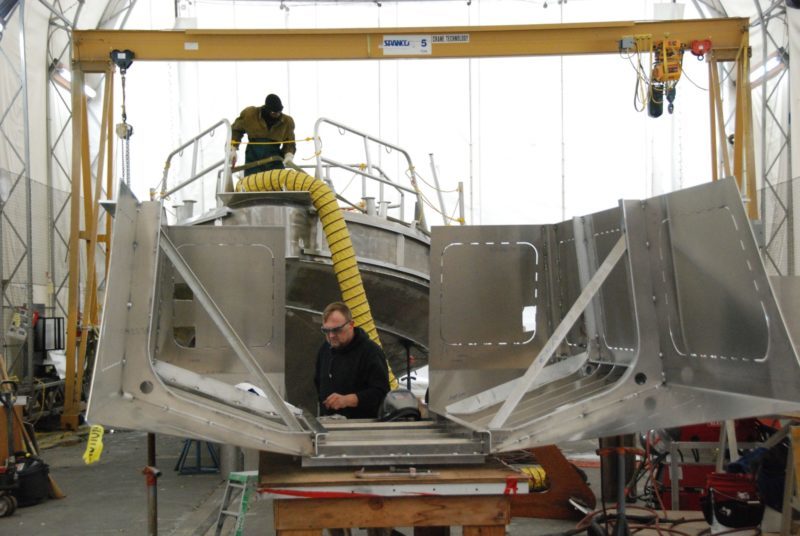From the main street it’s easy to miss the corner where Kvichak Marine Industries is tucked into the north side of the canal linking Salmon Bay and Union Lake — especially in the rain and brutal morning traffic of Seattle in November.
But there is no mistaking the continuing effect of Kvichak aluminum fabricating skills on the Northwest shipbuilding business. Since a merger in 2015, Kvichak is now Vigor Ballard, a wholly owned subsidiary of Vigor Industrial, and its heritage continues in major boatbuilding programs.
I got a chance to get a look yesterday, the day before the start of the Pacific Marine Expo in Seattle. A lot was going on.
Inside two high-ceiling fabrication buildings, hulls were taking shape for the fourth Hydrus-class catamaran ferry, 134’x38’x6.5’ Incat Crowther designed boats that carry up to 400 passengers on San Francisco Bay that was named a WorkBoat Significant Boat of 2017.
Tied up on the canal, another new 45’ boat for the New York Police Department was being finished. Inside the fabrication spaces, other versions of the hugely successful response boat-medium (RB-M) originally designed for the U.S. Coast Guard were being built for export to Jordan.

The catamaran hull for a third San Francisco Bay Ferry at Vigor Industrial's Harbor Island facility. Vigor Industrial photo.
The Vigor-Kvichak merger brought together Kvichak’s expertise with aluminum and Vigor’s heavy shipbuilding capabilities, and applied them to the San Francisco Bay Ferry building program for northern California’s Water Emergency Transportation Authority.
Now workers move between Ballard and Vigor’s bigger operation at Harbor Island for different phases of the program, and the third WETA ferry is nearing completion at Harbor Island, said Carol Reid, Vigor marketing manager.
This time last year I got a good look at Vigor’s work on the Washington State Ferries too. It is impressive to see this quality of work.
I heard that again later in the day, with a group from National Fisherman that toured a U.S.-flag freezer-processor vessel undergoing a major refit in Seattle.
“There’s still a lot of this craftsmanship in the Northwest,” our guide told us. With about 100 people still at work on that project, the goal is to have the ship working again in 2018, selling frozen fillets and surimi product in Japan, South Korea, Europe and the U.S. — one positive flow in our trade imbalance.
Something to consider the next time someone says it’s cheaper to build vessels overseas? Just saying.




